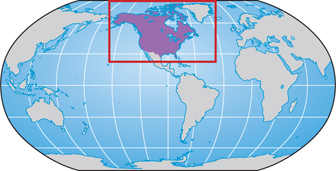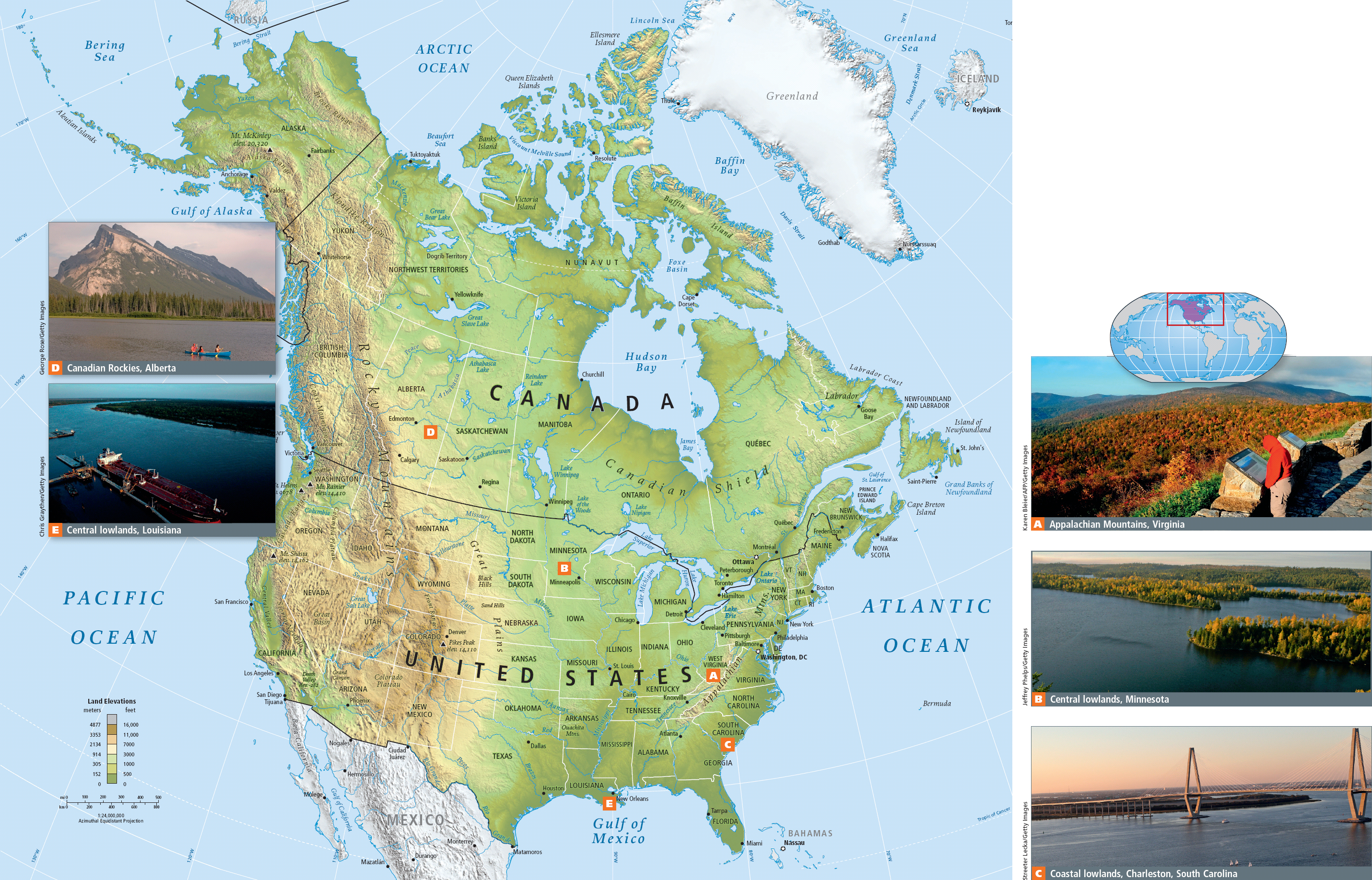2.1 Chapter 2 NORTH AMERICA
58
59

chapter 2
NORTH AMERICA▶
60
GEOGRAPHIC INSIGHTS
After you read this chapter, you will be able to discuss the following issues as they relate to the five thematic concepts:
|
1. |
Environment: |
North America’s intensive use of resources has an enormous impact on the environment. Although home to only 5 percent of the world’s population, North America produces 26 percent of the greenhouse gases released globally that are related to human activity. North American lifestyles have major environmental impacts, including the depletion and pollution of water resources and fisheries and the destruction of huge amounts of habitat for wild plants and animals. |
|
2. |
Globalization and Development: |
Globalization has transformed economic development in North America, reorienting employment toward knowledge- |
|
3. |
Power and Politics: |
North America has relatively high levels of political freedom, though in recent decades many of its residents have become disillusioned with the political process for a variety of reasons. While Canada plays a relatively modest political role abroad, the United States has enormous influence on the global political order, although its status as the world’s predominant “superpower” is increasingly being challenged. |
|
4. |
Urbanization: |
A dramatic change in the spatial patterns of cities and suburbs has profoundly affected life in this very urbanized region. Since World War II, North America’s urban populations have increased by about 150 percent, but the amount of land they occupy has increased by almost 300 percent. This is primarily because of suburbanization and urban sprawl, which are companion processes to urbanization. |
|
5. |
Population and Gender: |
Women’s participation in North America’s economy is beginning to rival that of men, contributing to more than two centuries of declining fertility rates as women delay childbearing to pursue education and careers. Declining childbirth rates play a major role in the aging of North American populations, which may slow economic growth. |
The North American Region
North America (Figure 2.1) is one of the largest, wealthiest, and most politically powerful regions in the world. It encompasses many environments and a complex array of local cultures and economic activities that interact with each other across wide distances. Many of the trends discussed throughout this book are well advanced in North America.

The five thematic concepts in this book are explored as they arise in the discussion of regional issues, with interactions between two or more themes featured. Vignettes, like the one that follows about Javier Aguilar, illustrate one or more of the themes as they are experienced in individual lives.
VIGNETTE
Javier Aguilar, a 39-

THINKING GEOGRAPHICALLY
Question 2.1
boW7FO7NmlwzaALyX2kLxmsPxlCZsEfk6wOEQ7rkXJA2ap1xoHwb6GZkRXBp0oJGUBBTEAwO2bjgxCSXm89X/E+KUh8CChaPuJPpNwZpk7g=In Mendota, also in California’s Central Valley, young Latino men wait on street corners to catch a van to the fields. None come. By March of 2009, the unemployment rate in Mendota was 41 percent and rising, and Mayor Robert Silva said his community was dying on the vine. He saw the trouble spreading. Many small businesses were closing. Silva worried about the drug use, alcohol abuse, family violence, and malnutrition that can accompany severe unemployment in any community.
This level of unemployment in the heart of the nation’s biggest producer of fruit, nuts, and vegetables was partly due to drought and partly to a global economic recession. The drought is related to natural dry cycles as well as to global climate change. Water is increasingly scarce in the Central Valley, and access to irrigation water has been cut to force conservation. Meanwhile, the global economic recession, which began in 2007 and continued into 2014, reduced overall demand for California’s fresh fruits and vegetables as families turned to cheaper foods or those grown closer to home. All of these stresses have forced farmers to remove from production as much as 1 million of the 4.7 million acres of land once cultivated and irrigated in the Central Valley. This may eventually result in a loss of as many as 80,000 jobs and as much as $2.2 billion in California agriculture and related industries. And even though by early 2014 agricultural production in Mendota had partially been revived, unemployment remained over 12 percent, nearly twice the national average.
61
The confluence of troubles in California’s Central Valley has been particularly devastating for low-
GLOBAL PATTERNS, LOCAL LIVES
What Makes North America a Region?
This world region is relatively easy to define. It consists of Canada and the United States, two countries that are linked because of their geographic proximity, similar history, and many common cultural, economic, and political features. The nature of the relationship between Canada and the United States is discussed in numerous places throughout the chapter.
Terms in This Chapter
The term North America is used to refer to both countries. Even though it is common on both sides of the border to call the people of Canada “Canadians” and people in the United States “Americans,” this text uses the term United States, or U.S., rather than America, for the United States. Other terms relate to the growing cultural diversity in this region. The text uses the term Latino to refer to all Spanish-
Latino a term used to refer to all Spanish-
THINGS TO REMEMBER
The global economic recession, which began in 2007 and continued into 2014, reduced overall demand for California’s fresh fruits and vegetables as families turned to cheaper foods or those grown closer to home.
The recession combined with drought forced farmers to remove from production as much as 1 million of the 4.7 million acres of land once cultivated and irrigated in the Central Valley. This may eventually result in a loss of as many as 80,000 jobs and as much as $2.2 billion in California agriculture and related industries.